
* US Navy efforts to develop SAMs paralleled those of the US Army, with the Navy initially working on the unsuccessful "Lark" naval SAM -- and then, through Project BUMBLEBEE, the "Talos" NSAM. Work on Talos also led to the "Terrier / Tartar" NSAM.
* Late in World War II, the US Navy ran into Japanese suicide aircraft attacks, the "kamikazes", which proved devastatingly effective against US Navy ships. The kamikazes led to interest in developing a medium-range air-defense system, with longer range than shipboard anti-aircraft guns, but leaving long-range defense to fighter sweeps.
The air-defense effort focused on guided missiles, being split between two projects. The first project, designated "Lark", was a fast-track project, with the Navy Bureau of Aeronautics issuing a preliminary requirement to industry in early 1945. A contract for a hundred Larks was issued to Fairchild in March 1945; because of slow progress by Fairchild, a second contract for a hundred missiles was issued to Convair in June.
The Fairchild Larks were initially designated "KAQ-1", later "XSAM-2" and then "XSAM-N-2"; the Convair Larks were initially designed "KAY-1", later "XSAM-4" and then "XSAM-N-4". Both the Fairchild and Convair missiles looked alike, being cylinders with tapered noses, plus cruciform wings and tailfins. Length was 4.24 meters (13 feet 11 inches), while wingspan was 1.88 meters (6 feet 2 inches), and launch mass was about 550 kilograms (1,220 pounds) -- with a 45-kilogram (100-pound) warhead, detonated by proximity fuze.
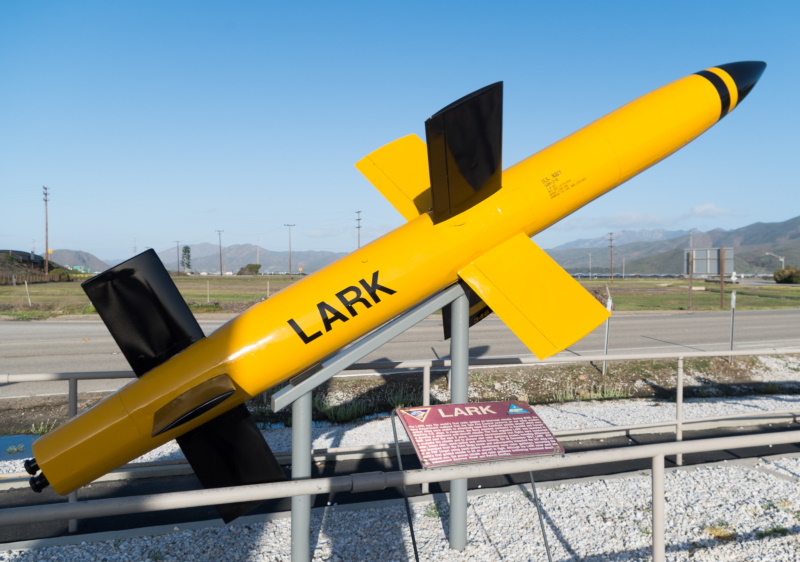
They were powered by a Reaction Motors LR2-RM-2 liquid-fuel rocket motor, with two thrust chamber -- one big for boost power, the other small for cruise power -- and burning "red fuming nitric acid" as fuel, which consisted of mostly nitric acid, plus some nitrogen tetroxide and water. It was as nasty as it sounds. Later items used the more powerful LR2-RM-6 engine, with the designations changed to "KAQ-2 / XSAM-2a / XSAM-N-2a" and "KAY-2" / XSAM-4a / XSAM-N-4a". The Lark was launched by twin rocket-assisted take-off (RATO) boosters in a frame, which added 1.4 meters (4 feet 7 inches) to the length, and 370 kilograms (810 pounds) to the weight. Maximum range was 55 kilometers (34 miles / 30 NMI).
The two different versions of Lark used different guidance methods:
Some Larks were used for trials in other programs, as discussed below. The Lark program was canceled in 1950; it was subsonic, and better options were available by that time.
BACK_TO_TOP* The other branch of effort towards developing NSAMs, known as the "BUMBLEBEE Project", proved much more successful. Initial work was performed by the Applied Physics Laboratory (APL), a government-oriented research organization, associated with Johns Hopkins University in Maryland.
At the outset, the Navy really wanted a long-range supersonic SAM that could intercept adversary attack aircraft before they got in range to release guided antiship weapons. The Navy specified a weapon with a horizontal range of 18.5 kilometers (11.5 miles / 10 NMI) and a ceiling limit of 9,150 meters (30,000 feet), with a circular error of 0.2% -- that is, within a 2-meter circle at 1,000 meters. The circular error dictated a large warhead.
At the time, ramjet propulsion was seen as the best way to meet the speed and range requirements, with flight tests from early 1945 from what would become known as "Burner Test Vehicles (BTV)" -- ramjet vehicles, early on launched with clusters of 12.7-centimeter (5-inch) High Velocity Aircraft Rockets (HVAR). Incidentally, there were of course a number of different versions of the BTV, and there's a tangle of names and designations; they're rendered down here to "BTV" here for simplicity. Initial flight were just aerodynamic tests, with dummy ramjets, but a functional ramjet with a diameter of 25 centimeters (10 inches) was finally flown in October 1945. By 1947, the BTVs had moved up to tests of a 45-centimeter (18-inch) ramjet.
In the meantime, there was work on guidance systems, starting with the "Control Test Vehicles (CTV)" -- which were Larks -- to test out beam-riding. They led to a series of beam-riding "Supersonic Test Vehicles (STV)", leading up to the "STV-3", which was a solid-fuel rocket, launched by a solid-fuel booster. At this point, the Bumblebee program was rethought, with the STV-3 looking like a pretty good short-range NSAM. All that really needed to be done was replace its telemetry module with a warhead and a fuze. The result would be the "Terrier" NSAM, discussed below.
Terrier could be fielded quickly -- which led to expanding the goals for the ramjet-powered missile, extending its range to 90 kilometers (55 miles / 50 NMI) or better, and adding a terminal homing seeker, along with beam-riding guidance. In early 1948, the ramjet-powered missile was given the name of "Talos" -- an ancient guardian demigod of the island of Crete. Talos, so legend went, was made of brass and could fly at great speed, becoming so red hot that he could incinerate enemies simply by grabbing on to them.

In any case, in 1949 the Talos program went on to the "Experimental Prototype Missile (XPM)" series, which had a 71-centimeter (28-inch) ramjet and were much more like operational weapons, with later members of the series featuring guidance systems. The XPMs led in turn in 1951 to flight prototypes for the production Talos missile, the prototype series being designated "XSAM-N-6" -- and then, in 1954, to the pilot-production "SAM-N-6b". Manufacture was performed by the Bendix corporation, with the McDonnell Corporation building the missile airframe as a subcontractor.
BACK_TO_TOP* The Talos NSAM, as it emerged, was essentially a "flying stovepipe", a simple tube with a ramjet, plus fuel, guidance, and warhead crammed in. It had four pivoting trapezoidal wings for guidance in midbody, and four fixed rectangular tailfins. It was launched by a Mark 11 solid-fuel booster, with four fixed fins; the missile just flew in the direction of launch until the booster was discarded, and then followed the guidance radar beam.
The warhead was in the ramjet centerbody, with electronics ringing the "stovepipe" behind that, and fuel ringing it behind that in turn. There was a receiver at the tail to track the radar guidance beam, and four antennas at the front -- along with a pitot tube -- for SARH homing. The warhead was detonated by a proximity fuze. SARH permitted the missile to be used as an antiship weapon, as a secondary capability. Images of Talos impacts on target hulks show they could do severe damage.
The initial production SAM-N-6b had a conventional warhead; it was complemented by the "SAM-N-6bw", which had a W30 nuclear warhead, with a yield of a few kilotons. The SAM-N-6bw didn't have a SARH terminal seeker, since it wasn't needed with a nuclear warhead. In 1956, production moved on to the "SAM-N-6b1" and "SAM-N-6bw1" -- conventional and nuclear variants respectively -- with range doubled to 180 kilometers (110 miles / 100 NMI).
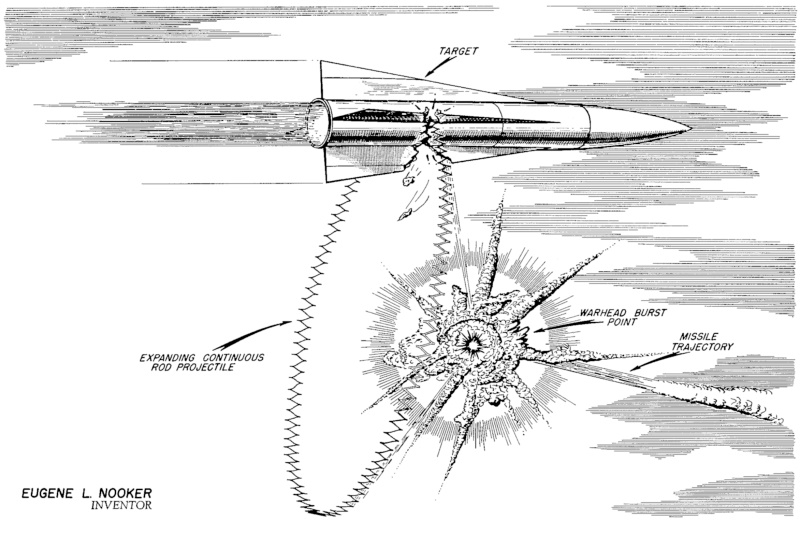
The SAM-N-6b1 also replaced the original fragmentation warhead with a "continuous-rod" warhead, which consisted of a set of steel rods wrapped around an explosive charge, with the rods connected together at the ends so they would expand into a ring that would slice through a target aircraft. Talos was declared operational in 1958. By 1960, production had consolidated on a "Unified Talos" variant, the "SAM-N-6c", that could be fitted with either a conventional or nuclear warhead. It also had a higher ceiling, and an improved SARH seeker. The new seeker was based on continuous-wave radar illumination; the seeker didn't need to gauge distance, it just needed a good signal to home in on.
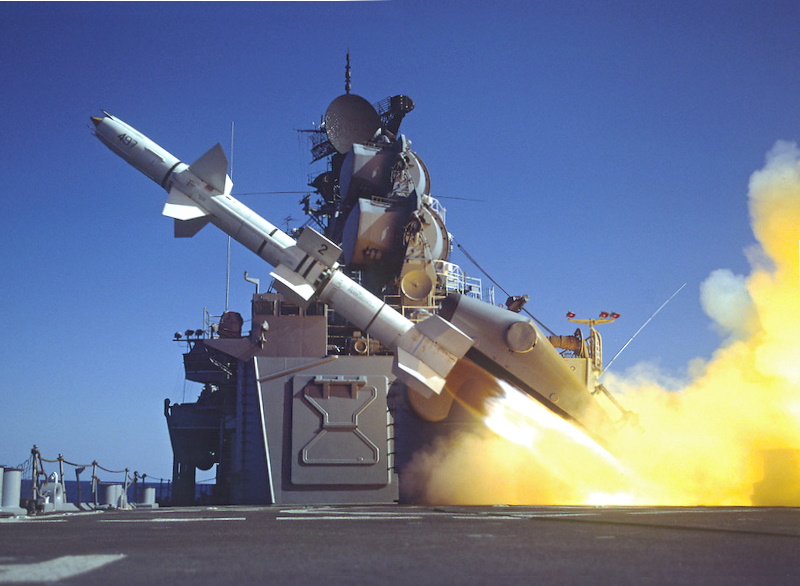
In 1962, the Pentagon adopted a multi-service common designation scheme, and so the Talos series got the designation of "RIM-8", where "RIM" stood for "Radar Intercept Missile":
The size of the Talos and the elaboration of its support systems meant it was only carried by seven US Navy cruisers:
Talos was never exported. A Talos launcher had twin arms that could pivot up and down, with the missiles slung under the arms, and the arms on a rotating post. There were two radars -- the AN/SPG-49 target illumination and tracking radar, and the AN/SPW-2 missile guidance radar, to provide the radar beam for the missile to ride. The beam-rider radar didn't necessarily point directly at the target, the radar instead tracing out the most efficient trajectory for the missile, not a straight-line attack.
___________________________________________________________________
RIM-8E TALOS NSAM:
___________________________________________________________________
missile wingspan:
2.9 meters (9 feet 6 inches)
missile length:
6.4 meters (21 feet)
missile diameter:
71 centimeters (28 inches)
missile weight:
1,540 kilograms (3,400 pounds)
warhead weight:
136 kilograms (300 pounds)
booster length:
5.2 meters (17 feet)
booster diameter:
76 centimeters (30 inches)
booster weight:
2,000 kilograms (4,400 pounds)
total length:
11.6 meters (38 feet)
total weight:
3,540 kilograms (7,800 pounds)
speed:
Mach 2.5
ceiling:
24,400 meters (80,100 feet)
range:
185 kilometers (115 MI / 100 NMI)
___________________________________________________________________
The new SARH seeker on the RIM-8E was retrofitted to some RIM-8Cs, these missiles then being redesignated "RIM-8F". There were also "RIM-8G" and "RIM-8J" variants, with consecutively refined seekers -- and maximum range extended to 240 kilometers (150 miles / 130 NMI), through use of a high-energy "dimer" fuel.
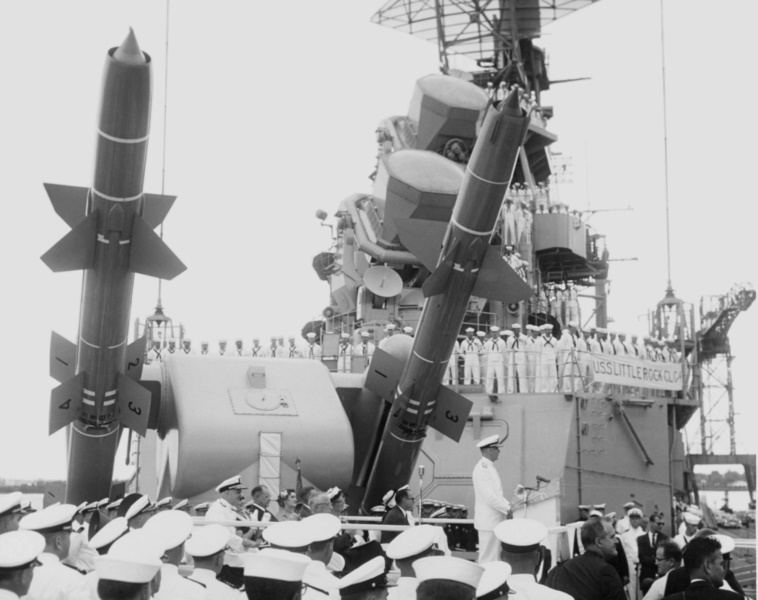
Talos saw action with the cruisers CHICAGO and LONG BEACH in the Vietnam War. LONG BEACH drew first blood on 23 May 1968, hitting a North Vietnamese MiG fighter at a range of 105 kilometers (65 miles), with a second MiG destroyed by flying into the debris. LONG BEACH destroyed a third MiG in September 1968. CHICAGO shot down a MiG on 9 May 1972, late in the war. These were the only aircraft shot down by Talos in combat.
In addition, there was the "RIM-8H Talos Anti-Radiation Missile (ARM)", which was a surface-to-surface weapon that would home in on a radar station or other "emitter". Presumably, the warhead was changed to a blast-fragmentation configuration. It was first flight-tested in 1965, and saw action in the Vietnam War with the CHICAGO, OKLAHOMA CITY, and LONG BEACH. The CHICAGO performed the first attack in early 1972 -- this being the first time a US Navy ship fired a long-range surface-to-surface missile.
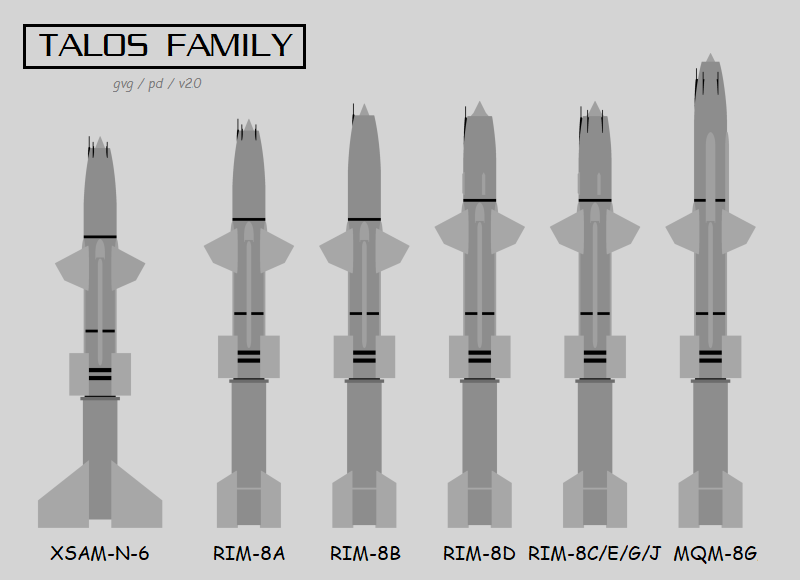
Talos was withdrawn from front-line service in 1979, with several hundred refurbished as "MQM-8G Vandal" targets, featuring a sea-skimming guidance system, and intended to emulate antiship missiles for naval training. The series included a stretched "Extended Range" variant, with GPS navigation fitted to some of the targets. The last Vandals were expended in 2008. A number of Talos rounds survive on static display.
* As a footnote to the Talos story, in the late 1950s the US Navy began to investigate a replacement for the Talos and the other naval SAMs developed in that decade. The biggest problem with the existing NSAMs was guidance, which demanded that each missile have its own dedicated targeting system -- which would leave a warship vulnerable if attacked by a mass of enemy aircraft.
The result was the "SAM-N-8 Typhon LR", later "RIM-50A", which was clearly derived from Talos, and indeed was known as the "Super Talos" early on. The name "Typhon" was from the Greek demigod of volcanoes. The Typhon featured a ramjet-powered missile stage and a solid-rocket booster stage. Its primary visible difference from the Talos missile was that Typhon had, instead of wings and tailfins, long narrow delta wings, with control surfaces at the tips. Like the Talos, the warhead was in the ramjet centerbody, and could be either conventional or nuclear.

The guidance system was based on midcourse navigation by an inertial navigation system (INS) with terminal SARH guidance, meaning the missile didn't have to be under control of shipboard radar systems at all times. It was to be under the direction of the AN/SPG-59 phased-array radar system, which would be able to track and engage multiple targets at the same time. The missile would have a secondary surface-to-surface capability.
___________________________________________________________________
RIM-50A TYPHON NSAM:
___________________________________________________________________
missile wingspan:
1.02 meters (3 feet 4 inches)
missile length:
4.72 meters (15 feet 6 inches)
missile diameter:
41 centimeters (16 inches)
missile weight:
770 kilograms (1,700 pounds)
warhead weight:
68 kilograms (150 pounds)
booster wingspan:
1.57 meters (5 feet 2 inches)
total length:
8.41 meters (27 feet 7 inches)
total weight:
1,640 kilograms (3,620 pounds)
speed:
Mach 4.0
ceiling:
29,000 meters (95,000 feet)
range:
370 kilometers (230 MI / 200 NMI)
___________________________________________________________________
Work on Typhon was conducted by the Bendix Corporation, with initial test launches in 1961 and sea trials in 1962. However, the cost of the program escalated painfully, while technical problems kept popping up -- the program was simply too ambitious for the technology available at the time. Typhon was finally canceled in 1963, with the Navy reconsidering requirements. There was also thought of "SAM-N-9 Typhon MR", later "RIM-55MR", originally named "Super Terrier" -- which, as the name suggests, was to be a Terrier follow-on. It never flew.
BACK_TO_TOP* The first test flight of an all-up Terrier was in 1953. It entered service in 1956, two years before Talos, with the first vessel to carry the weapon being the USS CANBERRA. It was produced by Convair -- which was purchased by General Dynamics in that year, with the Convair name being dropped early in the next decade. The initial variant was the "SAM-N-7 / BW-0" -- the "BW" meaning "beam-riding, wing-controlled" -- which was quickly replaced by the "BW-1", which was much the same, except for redesigned electronics and generally better reliability.
The Terrier, as it emerged, was configurationally broadly similar to the Talos, with a missile featuring cruciform pivoting wings in mid-length, plus fixed cruciform tailfins. The missile differed by being powered by solid-fuel rocket motor, not a ramjet -- and it was strictly a beam rider, with no SARH capability. It could only engage subsonic targets; it had a top speed of only Mach 1.8, and a range of only 19 kilometers (12 miles).

Early on in the Terrier development program, a push began to develop an improved "Terrier II", with test flights of "STV-4" and then "STV-5" vehicles. The STV-5 led to the "BT-3", which was introduced in 1958, the "BT" meaning "beam-riding, tail controlled". It was still purely a beam-rider, but replaced the wings with fixed strakes, with control provided by the tailfins, which substantially improved the missile's agility. It had Mach 3 performance and could engage supersonic targets.
It was followed by the "BT-3A", which doubled the range to about 37 kilometers (23 miles / 20 NMI), along with the "BT-3A(N)", which was fitted with a W45 nuclear warhead, with a kiloton yield. It was the only nuclear Terrier. The "HT-3" variant introduced SARH terminal homing -- the "HT" meant "homing Terrier" -- primarily to make the Terrier more effective against low-flying targets. SARH also allowed it to be used as an antiship weapon. The Terrier II had envisioned SARH terminal guidance all along, but it proved difficult, and so had to be put off.
In 1962, Terrier designations were revised as follows:
After 1962, one more version was introduced, the "RIM-2F", which featured:
The RIM-2F was also known as the "HTR-3", for "homing Terrier retrofit". The last Terriers were produced in 1966, after manufacture of about 8,000 missiles.
___________________________________________________________________
RIM-2E (SS-N-7 HT-3) TERRIER NSAM:
___________________________________________________________________
missile length:
4.6 meters (15 feet)
missile wingspan:
61 centimeters (24 inches)
missile tailfin span:
1.07 centimeters (42.3 inches)
missile diameter:
34 centimeters (13.5 inches)
missile weight:
535 kilograms (1,180 pounds)
warhead weight:
100 kilograms (218 pounds)
booster length:
3.4 meters (11 feet 4 inches)
booster weight:
825 kilograms (1,820 pounds)
total length:
8.0 meters (26 feet 4 inches)
total weight:
1,360 kilograms (3,000 pounds)
speed:
Mach 3.0
ceiling:
24,000 meters (80,000 feet)
range:
32 kilometers (19.8 MI / 17.3 NMI)
___________________________________________________________________
The Terrier ended up being a standard US Navy weapon, being carried on missile cruisers and guided-missile destroyers. It was fired from a Mark 10 twin-arm launcher, similar to that of Talos. Ships typically had a 40-round rear-loading magazine, but some vessels had magazines with 60 or 80 rounds -- while the heavy guided-missile cruisers USS BOSTON and USS CANBERRA featured a bottom-loading magazine with 72 rounds.

Terrier was also operated by the navies of Italy and the Netherlands. It doesn't seem the Terrier saw much action. On 19 April 1972, a Terrier launched by the guided missile cruiser USS STERETT, 1972, a Terrier missile fired by USS STERETT shot down a North Vietnamese MiG-17F. It's hard to find records of any other kills.
* The US Marines actually used the Terrier as a ground-based SAM for two years in the 1950s, missiles being fired from a transportable version of the sea launcher, which was complemented by a support vehicle that could carry reloads. It was the first SAM used by the Marines. It was replaced by the Raytheon Hawk SAM in Marine service.
The Terrier booster rocket was leveraged by the Army into a booster rocket for the Army Nike Ajax SAM. Retired boosters from Talos, Terrier, and Nike Ajax were used with sounding rockets -- with such boosters occasionally fitted in tandem combinations or pairs.
BACK_TO_TOP* Terrier was still too big for smaller ships like frigates, and so the solid-rocket rocket booster was dropped from the RIM-2E, with the result being the short-range "RIM-24A Tartar" NSAM, introduced in 1963. It featured a continuous-rod warhead, and a Mark I dual-thrust (boost-sustain) solid-rocket motor -- Terrier never used a dual-thrust motor, since Terriers had the booster stage. Range of the RIM-24A was 16 kilometers (10 miles / 9 NMI), with ceiling up to about 15,000 meters (50,000 feet).
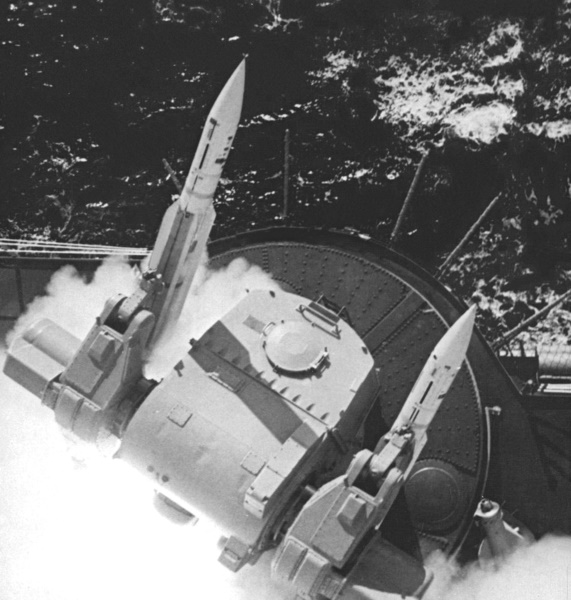
The RIM-24A was followed by the "RIM-24B", which was about 12 centimeters (5 inches) longer and featured with an improved seeker, a more potent warhead, plus a new Mark 27 dual-thrust motor that extended range to 30 kilometers (18 miles / 16 NMI), and raised ceiling to 20,000 meters (65,000 feet). Many Tartars were modified under the "Tartar Reliability Improvement Program (TRIP)" AKA "Improved Tartar Retrofit (ITR)", with solid-state electronics, better counter-countermeasures, and the ability to engage more than one target. They also had slightly improved range and ceiling, because they were lighter. Missiles given the TRIP were redesignated "RIM-24C".
___________________________________________________________________
RIM-24C TARTAR NSAM:
___________________________________________________________________
wingspan:
61 centimeters (24 inches)
tailfin span:
107 centimeters (42.3 inches)
length:
4.6 meters (15 feet)
diameter:
34 centimeters (13.5 inches)
weight:
590 kilograms (1,310 pounds)
warhead weight:
60 kilograms (130 pounds)
speed:
Mach 1.8
ceiling:
20,000 meters (65,000 feet)
range:
32 kilometers (19.8 MI / 17.3 NMI)
___________________________________________________________________
All Tartar variants had an antiship capability, using SARH for terminal attack, with a maximum range -- clearly limited by radar line-of-sight -- of about 18 kilometers (11 miles). The Tartar was initially launched from the twin-arm Mark 11 launcher, later from the Mark 13 and then Mark 22 single-arm launcher. Foreign navies that adopted the Tartar included those of Australia, France, Germany, Italy, Japan, and the Netherlands. The Germans investigated a dedicated antiship version of the Tartar, with a Bullpup air-to-surface missile warhead, but obtained the French MM38 Exocet antiship missile instead.
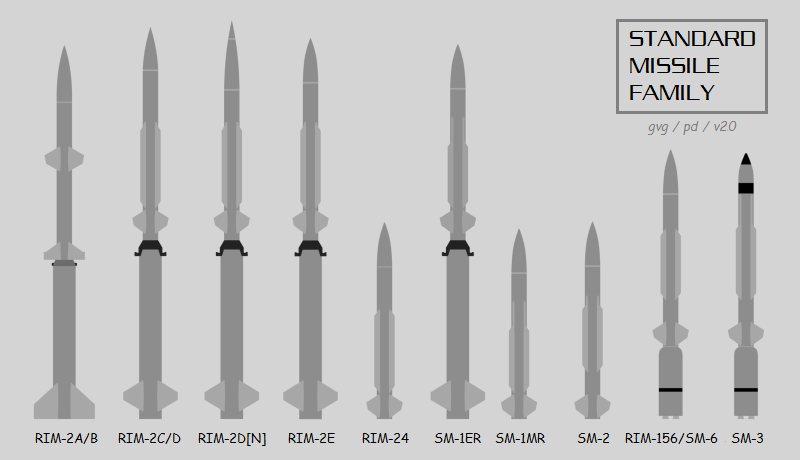
* France, as noted, was a Tartar user, and decided to use as a basis for a Terrier-like SAM, the "MASURCA" -- an acronym for "Marine Surface Contre-Avions / Naval Surface [vessel] Anti-Aircraft". The "Mark 1 Mod 1" was a prototype weapon; the "Mark 2 Mod 2" was the first operational version, being introduced in 1968.
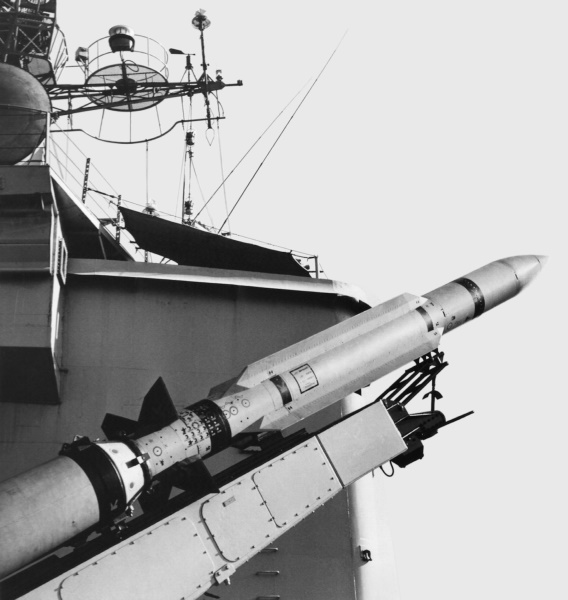
The missile itself looked like a Tartar, but had a French-made solid-rocket booster with different proportions from that of the Terrier. The MASURCA was fired from a twin-rail launcher, with 17 missiles in a horizontal-loading magazine. Sources are very confusing on guidance; it appears the Mod 2 was command-guided, with no terminal homing, and a proximity fuze for detonation.
A "Mark 2 Mod 3" version replaced the Mod 2 from 1975, this version adding SARH for terminal attack. The MASURCA saw service on the frigates SUFFREN and DUQUESNE, as well as the guided-missile cruiser COLBERT. The MASURCA was finally withdrawn in 2008.
BACK_TO_TOP